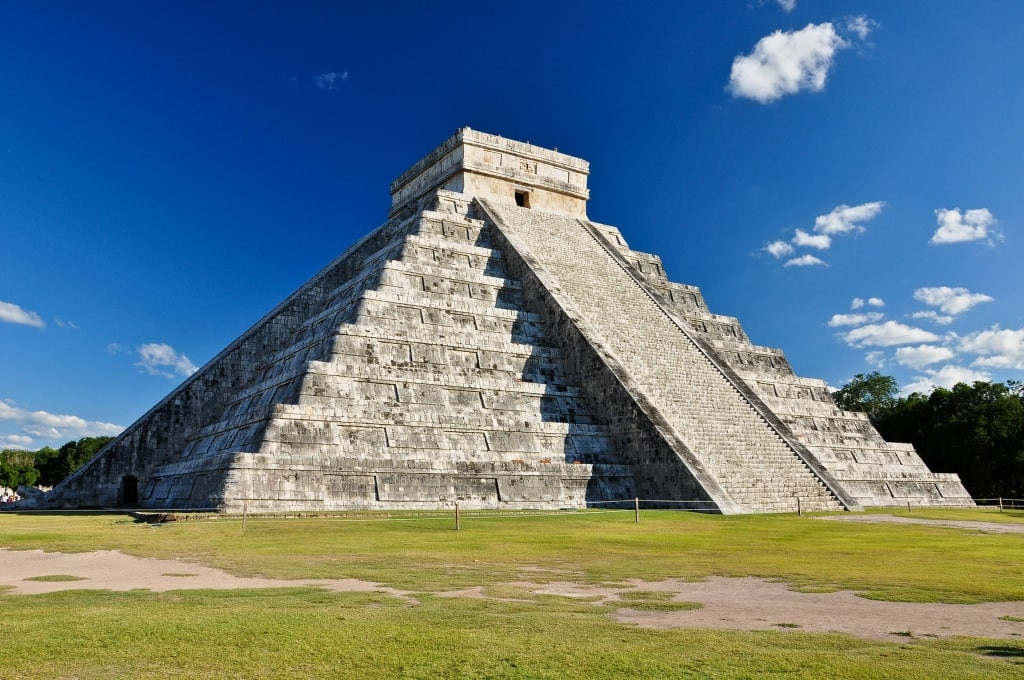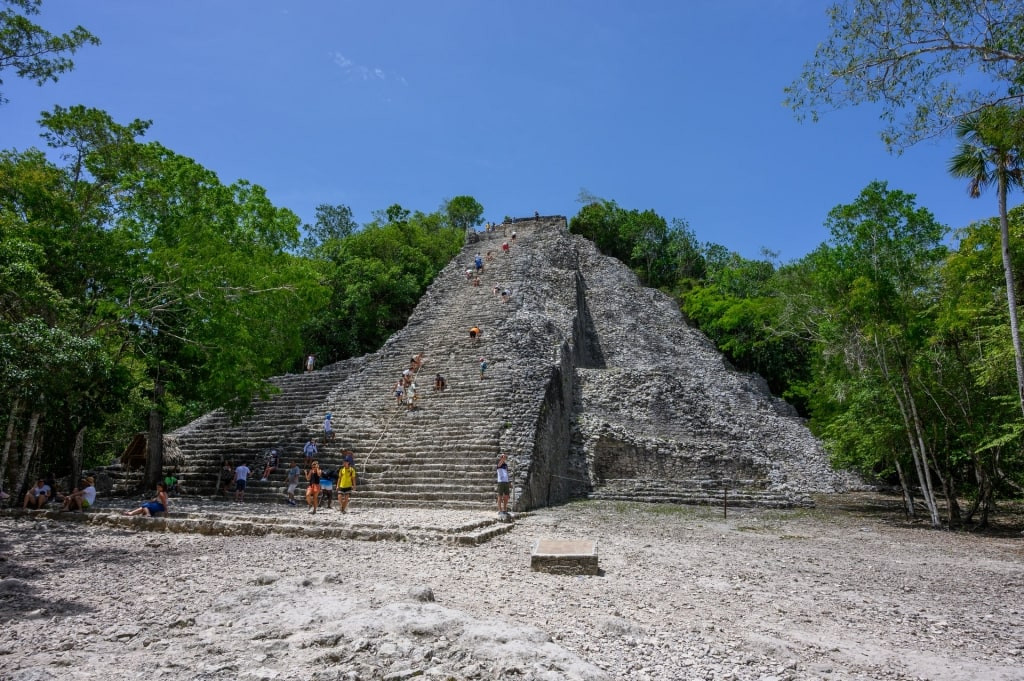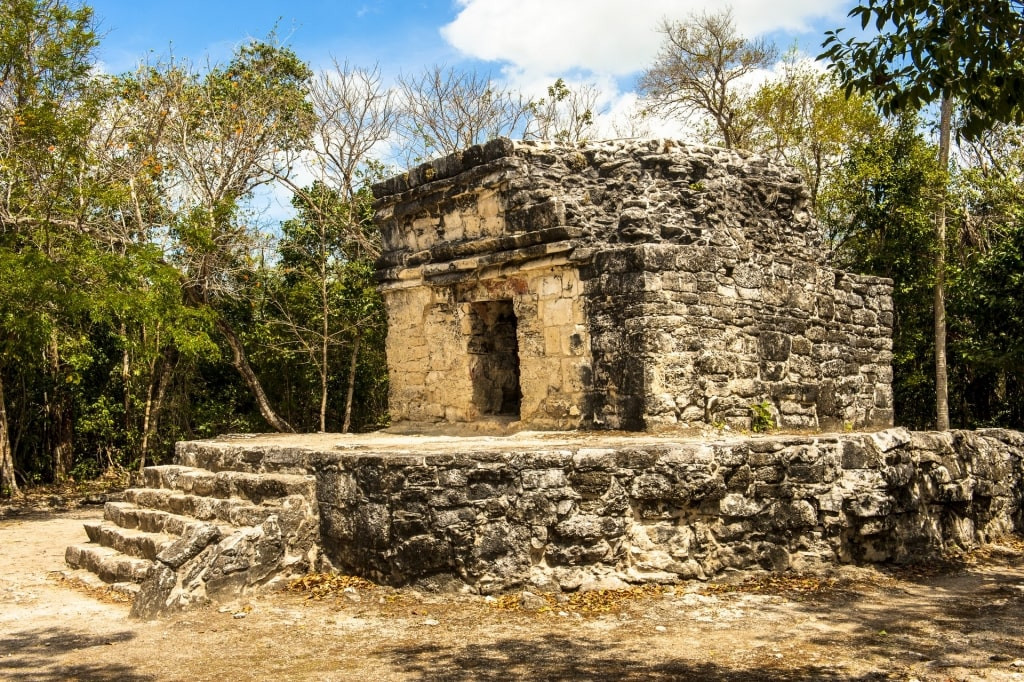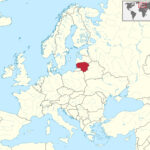Mexico is famous for its vibrant culture, delicious cuisine, and stunning landscapes, and at gaymexico.net, we’re dedicated to showcasing the country’s welcoming embrace of the LGBTQ+ community. Discover Mexico’s diverse LGBTQ+ scene, from the lively gay bars of Puerto Vallarta to the historical landmarks of Mexico City, through cultural richness, culinary delights, and breathtaking scenery.
1. What Are The Iconic Mayan Ruins That Mexico Is Famous For?
Mexico is famous for its iconic Mayan ruins, a testament to the rich history of the Maya people dating back to 2600 BC, and these atmospheric archaeological sites are a major draw for tourists. Sites like Chichen Itza, Coba, and San Gervasio offer a glimpse into this fascinating civilization.
Chichen Itza
Chichen Itza, located in the Yucatan state, is possibly the most iconic Mayan site in Mexico. The ancient city features a total of 26 separate ruins and is considered one of the New Seven Wonders of the World.
 Chichen Itza, an iconic Mayan ruin in Mexico, showcasing its pyramid shape and historical significance.
Chichen Itza, an iconic Mayan ruin in Mexico, showcasing its pyramid shape and historical significance.
Key Features of Chichen Itza:
- El Castillo: The famous pyramid-shaped structure with 91 steps on each of its four sides.
- Equinox Phenomenon: During the spring or autumn equinoxes, shadows create the appearance of a snake-like shape on El Castillo.
- Cenotes and Caves: The four-square-mile grounds are filled with intriguing structures, cenotes, and caves.
LGBTQ+ Consideration: While Chichen Itza itself doesn’t have specific LGBTQ+ attractions, its historical and cultural significance makes it a worthwhile visit.
Coba
Another incredible set of Mayan antiquities to explore is Coba, near Tulum. Here, visitors can wander the stone roads in the midst of the lush jungle for an otherworldly experience.
 The massive pyramid of Ixmoja in Coba, showcasing the ancient Mayan architecture amidst the lush Yucatan jungle.
The massive pyramid of Ixmoja in Coba, showcasing the ancient Mayan architecture amidst the lush Yucatan jungle.
Key Features of Coba:
- Nohoch Mul Pyramid: The tallest pyramid on the Yucatan Peninsula, offering stunning views.
- Mayan Hieroglyphic Inscriptions: Admire the intricate carvings that tell the story of the Maya.
- Guided Tours: Learn about the history of the Maya, their way of life, and the purpose of each structure.
LGBTQ+ Consideration: Coba offers a serene escape and a chance to connect with nature and history. The open-minded atmosphere of nearby Tulum extends to this archaeological site.
San Gervasio, Cozumel
On Cozumel, you can visit the impressive archaeological site of San Gervasio, a sacred place for ancient Mayan pilgrimages. It is believed that Ixchel, the goddess of fertility, was worshiped here.
 Historic Mayan ruins in San Gervasio, Cozumel, depicting an ancient sacred site with stone structures and roads.
Historic Mayan ruins in San Gervasio, Cozumel, depicting an ancient sacred site with stone structures and roads.
Key Features of San Gervasio:
- Ixchel Worship: A sacred place where the goddess of fertility was worshiped.
- Sacbés: Various temples linked by white stone roads.
- UNESCO World Heritage Site: Recognized for its historical and cultural significance.
LGBTQ+ Consideration: Cozumel is known for being a welcoming destination, and San Gervasio provides a unique cultural experience.
2. What Are The Most Popular Beach Destinations In Mexico?
Mexico is famous for its breathtaking beach destinations, offering a diverse range of experiences from tranquil escapes to vibrant party scenes. Popular spots include Cancun, Puerto Vallarta, and Tulum.
Cancun
Cancun is renowned for its pristine white-sand beaches, turquoise waters, and lively nightlife. It’s a top destination for tourists seeking both relaxation and excitement.
Key Features of Cancun:
- Hotel Zone: A strip of hotels, resorts, and nightclubs along the coast.
- Water Activities: Snorkeling, diving, and jet-skiing are popular.
- Nightlife: Cancun boasts a vibrant party scene with numerous bars and clubs.
LGBTQ+ Consideration: Cancun has a growing LGBTQ+ scene, with several gay-friendly hotels and bars.
Puerto Vallarta
Puerto Vallarta is known as one of the most gay-friendly cities in Mexico, featuring a welcoming atmosphere, beautiful beaches, and a thriving LGBTQ+ community.
Key Features of Puerto Vallarta:
- Zona Romantica: The heart of the gay scene, with numerous gay bars, clubs, and restaurants.
- Los Muertos Beach: A popular beach with a gay section.
- Cultural Attractions: Art galleries, markets, and historical sites.
LGBTQ+ Hotspots:
- Paco’s Ranch: A lively gay nightclub with drag shows and dancing.
- Mantamar Beach Club: A popular gay beach club with a pool, bar, and restaurant.
Tulum
Tulum combines stunning beaches with ancient Mayan ruins, offering a unique and bohemian vibe. It’s a favorite among travelers seeking a more laid-back and eco-friendly experience.
Key Features of Tulum:
- Tulum Archaeological Site: Mayan ruins perched on a cliff overlooking the Caribbean Sea.
- Eco-Friendly Resorts: Many resorts focus on sustainability and wellness.
- Cenotes: Natural sinkholes perfect for swimming and exploring.
LGBTQ+ Consideration: Tulum is becoming increasingly popular with LGBTQ+ travelers, drawn to its inclusive atmosphere and stunning natural beauty.
3. What Are The Most Unique Cultural Traditions In Mexico?
Mexico is famous for its unique cultural traditions, deeply rooted in its history and celebrated with vibrant festivals, music, and dance. Key traditions include Día de los Muertos, Cinco de Mayo, and the Guelaguetza festival.
Día de los Muertos (Day of the Dead)
Día de los Muertos is a vibrant celebration honoring deceased loved ones. Families create altars adorned with flowers, photos, and favorite foods of the departed.
Key Features of Día de los Muertos:
- Ofrendas (Altars): Decorated altars with offerings for the deceased.
- Calaveras (Skulls): Sugar skulls decorated with colorful designs.
- Marigolds: Used to guide spirits to the altars.
LGBTQ+ Consideration: Día de los Muertos is a deeply personal and inclusive celebration, where LGBTQ+ individuals can honor their loved ones and express their cultural identity.
Cinco de Mayo
Cinco de Mayo commemorates the Mexican army’s victory over French forces at the Battle of Puebla in 1862. It’s celebrated with parades, music, and traditional Mexican food.
Key Features of Cinco de Mayo:
- Parades and Festivals: Celebrations with traditional music and dance.
- Mexican Cuisine: Enjoying traditional dishes like mole and enchiladas.
- Historical Significance: Remembering the Battle of Puebla.
LGBTQ+ Consideration: Cinco de Mayo is a celebration of Mexican heritage and pride, and LGBTQ+ individuals participate in the festivities, showcasing their contributions to Mexican culture.
Guelaguetza Festival
The Guelaguetza Festival, held in Oaxaca, showcases the cultural diversity of the region with traditional dances, music, and costumes from different indigenous communities.
Key Features of Guelaguetza:
- Traditional Dances: Performances from different regions of Oaxaca.
- Indigenous Costumes: Vibrant and elaborate attire representing each community.
- Cultural Exchange: A celebration of Oaxaca’s diverse heritage.
LGBTQ+ Consideration: The Guelaguetza Festival is a celebration of diversity and inclusion, and LGBTQ+ individuals are welcomed to participate and share their unique cultural expressions.
4. What Are The Most Famous Mexican Dishes?
Mexico is famous for its exquisite cuisine, a blend of indigenous and Spanish influences that has earned it UNESCO World Heritage status. Popular dishes include tacos, mole, and enchiladas.
Tacos
Tacos are a staple of Mexican cuisine, consisting of a tortilla filled with various meats, vegetables, and toppings.
Key Features of Tacos:
- Variety of Fillings: From carne asada to al pastor, there’s a taco for every taste.
- Toppings: Common toppings include salsa, onions, cilantro, and guacamole.
- Regional Variations: Different regions have their own unique taco styles.
LGBTQ+ Consideration: Tacos are a universally loved dish, and LGBTQ+ individuals enjoy exploring the diverse taco offerings throughout Mexico.
Mole
Mole is a complex sauce made from chili peppers, chocolate, spices, and other ingredients. It’s often served with chicken or turkey.
Key Features of Mole:
- Complex Flavor: A rich and layered flavor profile.
- Regional Variations: Different regions have their own mole recipes.
- Traditional Preparation: Mole is often prepared for special occasions.
LGBTQ+ Consideration: Mole is a celebrated dish in Mexican cuisine, and LGBTQ+ chefs and food enthusiasts contribute to its ongoing evolution and appreciation.
Enchiladas
Enchiladas are tortillas filled with meat, cheese, or vegetables, covered in sauce, and baked.
Key Features of Enchiladas:
- Variety of Fillings: Options include chicken, beef, cheese, and beans.
- Sauces: Red, green, and mole sauces are commonly used.
- Toppings: Often topped with cheese, sour cream, and onions.
LGBTQ+ Consideration: Enchiladas are a comforting and versatile dish, and LGBTQ+ individuals enjoy creating their own variations and sharing them with friends and family.
5. What Are Some Popular Cultural Landmarks In Mexico City?
Mexico is famous for its cultural landmarks in Mexico City, which reflect its rich history, art, and architecture, including the Palacio de Bellas Artes, the National Museum of Anthropology, and the historic center.
Palacio de Bellas Artes
The Palacio de Bellas Artes is a stunning cultural center known for its Art Nouveau and Art Deco architecture, as well as its murals by famous Mexican artists.
Key Features of Palacio de Bellas Artes:
- Architecture: A blend of Art Nouveau and Art Deco styles.
- Murals: Diego Rivera, David Alfaro Siqueiros, and José Clemente Orozco created murals here.
- Performing Arts: Hosts opera, ballet, theater, and music performances.
LGBTQ+ Consideration: The Palacio de Bellas Artes is a symbol of Mexican culture and artistic expression, and LGBTQ+ artists and performers have contributed to its rich history.
National Museum of Anthropology
The National Museum of Anthropology houses an extensive collection of pre-Columbian artifacts, providing insights into Mexico’s ancient civilizations.
Key Features of the National Museum of Anthropology:
- Extensive Collection: Artifacts from Mayan, Aztec, and other ancient cultures.
- Historical Significance: Provides insights into Mexico’s pre-Columbian history.
- Architectural Design: The museum itself is an architectural masterpiece.
LGBTQ+ Consideration: The museum showcases the diverse cultural heritage of Mexico, and LGBTQ+ individuals find connections to their identities through the stories and artifacts on display.
Historic Center of Mexico City
The Historic Center of Mexico City, a UNESCO World Heritage Site, features stunning colonial architecture, historic squares, and iconic landmarks like the Metropolitan Cathedral and the Templo Mayor.
Key Features of the Historic Center:
- Colonial Architecture: Beautiful buildings from the Spanish colonial period.
- Zócalo: The main square, surrounded by historic buildings.
- Templo Mayor: Ruins of an ancient Aztec temple.
LGBTQ+ Consideration: The Historic Center is a vibrant and inclusive area, where LGBTQ+ individuals can explore the city’s history, culture, and vibrant street life.
6. What Natural Wonders Can Be Found In Mexico?
Mexico is famous for its breathtaking natural wonders, ranging from stunning beaches and cenotes to majestic mountains and vibrant coral reefs. Highlights include the cenotes of the Yucatan Peninsula, Copper Canyon, and the Monarch Butterfly Biosphere Reserve.
Cenotes of the Yucatan Peninsula
The Yucatan Peninsula is known for its cenotes, natural sinkholes filled with crystal-clear freshwater, perfect for swimming and exploring.
Key Features of the Cenotes:
- Crystal-Clear Water: Ideal for swimming and snorkeling.
- Unique Geological Formations: Underground caves and rock formations.
- Mayan Significance: Considered sacred by the ancient Maya.
LGBTQ+ Consideration: Cenotes offer a serene and natural escape, and LGBTQ+ travelers enjoy exploring these unique geological wonders.
Copper Canyon
Copper Canyon, located in Chihuahua, is a network of deep canyons larger and older than the Grand Canyon, offering stunning views and opportunities for hiking and exploring.
Key Features of the Copper Canyon:
- Dramatic Landscapes: Deep canyons and towering cliffs.
- Adventure Activities: Hiking, zip-lining, and horseback riding.
- Indigenous Cultures: Home to various indigenous communities.
LGBTQ+ Consideration: Copper Canyon provides a sense of adventure and connection with nature, and LGBTQ+ travelers can experience the beauty and solitude of this natural wonder.
Monarch Butterfly Biosphere Reserve
The Monarch Butterfly Biosphere Reserve, in the mountains of central Mexico, is a sanctuary for millions of monarch butterflies that migrate here each winter.
Key Features of the Monarch Butterfly Biosphere Reserve:
- Butterfly Migration: Witnessing the incredible migration of monarch butterflies.
- Conservation Efforts: Protecting the butterflies and their habitat.
- Natural Beauty: Lush forests and mountain landscapes.
LGBTQ+ Consideration: The Monarch Butterfly Biosphere Reserve symbolizes transformation and resilience, qualities that resonate with the LGBTQ+ community.
7. What Are The Most Popular Festivals In Mexico?
Mexico is famous for its lively and colorful festivals, reflecting its rich cultural heritage. Key festivals include Día de los Muertos, Cinco de Mayo, and the Guelaguetza festival.
Día de los Muertos (Day of the Dead)
Día de los Muertos is a vibrant celebration honoring deceased loved ones. Families create altars adorned with flowers, photos, and favorite foods of the departed.
Key Features of Día de los Muertos:
- Ofrendas (Altars): Decorated altars with offerings for the deceased.
- Calaveras (Skulls): Sugar skulls decorated with colorful designs.
- Marigolds: Used to guide spirits to the altars.
LGBTQ+ Consideration: Día de los Muertos is a deeply personal and inclusive celebration, where LGBTQ+ individuals can honor their loved ones and express their cultural identity.
Cinco de Mayo
Cinco de Mayo commemorates the Mexican army’s victory over French forces at the Battle of Puebla in 1862. It’s celebrated with parades, music, and traditional Mexican food.
Key Features of Cinco de Mayo:
- Parades and Festivals: Celebrations with traditional music and dance.
- Mexican Cuisine: Enjoying traditional dishes like mole and enchiladas.
- Historical Significance: Remembering the Battle of Puebla.
LGBTQ+ Consideration: Cinco de Mayo is a celebration of Mexican heritage and pride, and LGBTQ+ individuals participate in the festivities, showcasing their contributions to Mexican culture.
Guelaguetza Festival
The Guelaguetza Festival, held in Oaxaca, showcases the cultural diversity of the region with traditional dances, music, and costumes from different indigenous communities.
Key Features of Guelaguetza:
- Traditional Dances: Performances from different regions of Oaxaca.
- Indigenous Costumes: Vibrant and elaborate attire representing each community.
- Cultural Exchange: A celebration of Oaxaca’s diverse heritage.
LGBTQ+ Consideration: The Guelaguetza Festival is a celebration of diversity and inclusion, and LGBTQ+ individuals are welcomed to participate and share their unique cultural expressions.
8. What Are Some Examples Of Mexican Art And Architecture?
Mexico is famous for its diverse art and architecture, blending indigenous traditions with colonial influences. Notable examples include the murals of Diego Rivera, the architecture of Luis Barragán, and traditional crafts like pottery and textiles.
Murals of Diego Rivera
Diego Rivera was a famous Mexican muralist whose works depict Mexican history, culture, and social issues. His murals can be found in various public buildings throughout Mexico.
Key Features of Diego Rivera’s Murals:
- Historical Themes: Depicting key events in Mexican history.
- Social Commentary: Addressing social and political issues.
- Large Scale: Covering entire walls and ceilings.
LGBTQ+ Consideration: Rivera’s murals often depict a diverse range of people, and his commitment to social justice resonates with the LGBTQ+ community.
Architecture of Luis Barragán
Luis Barragán was a renowned Mexican architect known for his minimalist designs, use of color, and incorporation of natural light and water features.
Key Features of Luis Barragán’s Architecture:
- Minimalist Design: Simple and elegant forms.
- Color: Using vibrant colors to create atmosphere.
- Natural Elements: Incorporating light, water, and gardens.
LGBTQ+ Consideration: Barragán’s architecture is celebrated for its beauty and tranquility, providing spaces for contemplation and connection with nature.
Traditional Crafts (Pottery and Textiles)
Mexican traditional crafts, such as pottery and textiles, showcase the country’s rich cultural heritage and artistic skills.
Key Features of Mexican Crafts:
- Handmade: Crafted using traditional techniques.
- Regional Variations: Different regions have their own unique styles.
- Cultural Significance: Reflecting local traditions and beliefs.
LGBTQ+ Consideration: Mexican crafts are a form of cultural expression, and LGBTQ+ artisans contribute to their creation and preservation.
9. What Are Some Of The Most Popular Drinks In Mexico?
Mexico is famous for its diverse and flavorful drinks, from traditional beverages like tequila and mezcal to refreshing options like agua fresca and horchata.
Tequila
Tequila is a distilled spirit made from the blue agave plant, primarily in the state of Jalisco. It’s a symbol of Mexican culture and is enjoyed in various forms, from shots to cocktails.
Key Features of Tequila:
- Blue Agave: Made from the blue agave plant.
- Regional Production: Primarily produced in Jalisco.
- Versatile Drink: Enjoyed in shots, margaritas, and other cocktails.
LGBTQ+ Consideration: Tequila is a popular drink in LGBTQ+ bars and celebrations, symbolizing fun and camaraderie.
Mezcal
Mezcal is another distilled spirit made from agave, but it can be produced from different types of agave plants and in various regions of Mexico. It’s known for its smoky flavor.
Key Features of Mezcal:
- Variety of Agave: Made from different types of agave plants.
- Smoky Flavor: A distinctive smoky taste.
- Traditional Production: Often produced using traditional methods.
LGBTQ+ Consideration: Mezcal is gaining popularity in LGBTQ+ circles, appreciated for its unique flavor and cultural significance.
Agua Fresca
Agua fresca is a refreshing drink made from fruit, water, and sugar. It’s a popular choice for staying cool in the Mexican heat.
Key Features of Agua Fresca:
- Fresh Fruit: Made from fresh fruits like watermelon, hibiscus, and lime.
- Refreshing: A light and hydrating drink.
- Variety of Flavors: Available in various flavors.
LGBTQ+ Consideration: Agua fresca is a refreshing and inclusive beverage, enjoyed by people of all backgrounds and identities.
10. What Are The Most Welcoming Cities In Mexico For LGBTQ+ Travelers?
Mexico is famous for its welcoming cities for LGBTQ+ travelers, offering inclusive environments, vibrant nightlife, and supportive communities. Top destinations include Puerto Vallarta, Mexico City, and Guadalajara.
Puerto Vallarta
Puerto Vallarta is known as the gay capital of Mexico, with a thriving LGBTQ+ scene, numerous gay bars and clubs, and a welcoming atmosphere.
Key Features of Puerto Vallarta:
- Zona Romantica: The heart of the gay scene.
- Gay Beaches: Los Muertos Beach is popular.
- LGBTQ+ Events: Pride celebrations and other events throughout the year.
LGBTQ+ Hotspots:
- Paco’s Ranch: A lively gay nightclub.
- Mantamar Beach Club: A popular gay beach club.
Mexico City
Mexico City offers a vibrant and diverse LGBTQ+ scene, with gay bars, clubs, and cultural events. The city is known for its progressive attitudes and inclusive atmosphere.
Key Features of Mexico City:
- Zona Rosa: The main gay neighborhood.
- LGBTQ+ Cultural Events: Film festivals, art exhibits, and pride celebrations.
- Progressive Laws: Mexico City has progressive laws protecting LGBTQ+ rights.
LGBTQ+ Hotspots:
- Kinky Bar: A popular gay nightclub.
- El Almacén: A gay cantina with a relaxed atmosphere.
Guadalajara
Guadalajara has a growing LGBTQ+ scene, with gay bars, clubs, and a welcoming community. The city is known for its cultural attractions and traditional Mexican charm.
Key Features of Guadalajara:
- Gay Village: A growing LGBTQ+ area.
- Cultural Attractions: Museums, theaters, and historical sites.
- Traditional Mexican Charm: A blend of modern and traditional culture.
LGBTQ+ Hotspots:
- Envy Club: A popular gay nightclub.
- Code Bar: A stylish gay bar with a relaxed atmosphere.
FAQ About What Mexico Is Famous For
What is Mexico most known for regarding its culture?
Mexico is most known for its vibrant culture, which includes its rich history, colorful festivals like Día de los Muertos, and distinctive cuisine. These elements reflect a blend of indigenous and Spanish influences.
Why is Mexico City famous?
Mexico City is famous for its historical landmarks, such as the Palacio de Bellas Artes and the Templo Mayor, plus its vibrant arts scene and diverse neighborhoods. It serves as a cultural, economic, and political hub for Mexico.
What makes Mexican cuisine unique?
Mexican cuisine is unique due to its complex flavors, use of indigenous ingredients, and regional variations. Dishes like mole and tacos showcase Mexico’s culinary diversity and historical influences.
How does Mexico celebrate Día de los Muertos?
Mexico celebrates Día de los Muertos by creating altars adorned with flowers, photos, and favorite foods of deceased loved ones. Families visit cemeteries, and the atmosphere is festive and commemorative.
What are some famous natural attractions in Mexico?
Some famous natural attractions in Mexico include the cenotes of the Yucatan Peninsula, Copper Canyon, and the Monarch Butterfly Biosphere Reserve. These sites offer unique and breathtaking experiences.
Which Mexican cities are most LGBTQ+-friendly?
Puerto Vallarta, Mexico City, and Guadalajara are among the most LGBTQ+-friendly cities in Mexico, known for their inclusive environments, vibrant nightlife, and supportive communities.
What role does tequila play in Mexican culture?
Tequila is a symbol of Mexican culture, representing tradition and celebration. It is produced from the blue agave plant primarily in Jalisco and is enjoyed in various forms.
What are some traditional Mexican crafts?
Traditional Mexican crafts include pottery, textiles, and wood carvings. These handmade items reflect regional styles and cultural heritage, showcasing the skills of local artisans.
Why is Mexico a popular tourist destination?
Mexico is a popular tourist destination due to its diverse attractions, including ancient ruins, beautiful beaches, vibrant culture, and welcoming atmosphere. The country offers something for every type of traveler.
How do Mexican festivals reflect the country’s cultural identity?
Mexican festivals, like Cinco de Mayo and the Guelaguetza Festival, showcase the country’s diverse heritage through traditional music, dance, and costumes. They celebrate community, history, and cultural pride.
For more information on LGBTQ+ travel, events, and community in Mexico, visit gaymexico.net. Address: 3255 Wilshire Blvd, Los Angeles, CA 90010, United States. Phone: +1 (213) 380-2177. Website: gaymexico.net.
Ready to explore Mexico’s beauty and inclusivity? Dive into gaymexico.net for detailed travel guides, event listings, and connections within the LGBTQ+ community. Plan your unforgettable Mexican adventure today and discover a world of vibrant culture and warm welcomes.
